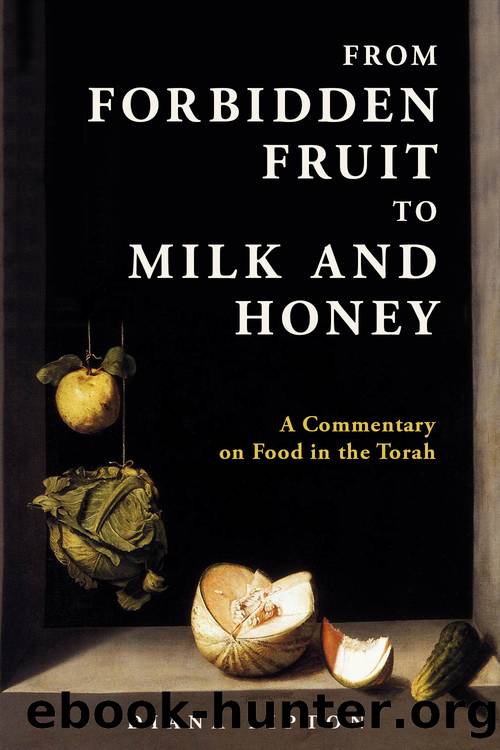02ForbiddenFruit by Unknown

Author:Unknown
Language: eng
Format: epub
Published: 2020-10-25T16:00:00+00:00
Shemini
Leviticus 9:1â11:47
The Vegetarian Ideal in the Bible*
Gary A. Rendsburg
Parashat Shemini, especially chapter 11, includes the most prominent treatment of permitted and forbidden animals in the Torah (the parallel text in Deuteronomy 14 is less detailed). Even after millennia of discussion, however, there is still no consensus as to why certain animals are permitted and why others are forbidden. The view I am presenting here builds on the work of other scholars before me.
We begin by recalling that the world was created with both humans and animals commanded to eat only vegetation (Gen 1:29â30, 2:9, 2:16 emphasized more in the first creation account, but present in the second one as well). Accordingly, we posit a vegetarian ideal, in line with a harmonious world established at creation. The humans could not live up to these standards established by God, and the Genesis narrative quickly moves on to disobedience (Gen 3:6), violence (Gen 4:8; 23), and improper sexual relations (Gen 6:1â4).
The result is the great flood, after which God lowers the bar for humanity, allowing for the eating of meat (Gen 9:3), though with the one important proviso: no consumption of blood (9:4). It is this latter point, I believe, which allows us to understand the Torahâs rationale in permitting certain species, while prohibiting others. In general, the permitted animals are all herbivores, as we may see from analyzing the various sub-divisions.
The permitted land animals are the three domesticated cloven-hoofed ruminants (sheep, goats, cattle), to which may be added one wild animal, the deer, including the many individual species subsumed in that category, such as the gazelle and the antelope (listed in Deut 14:5) â all of them herbivores.
Fish must have fins and scales in order to be eaten, and this description therefore excludes the various scavengers on the river bed or the ocean bed, such as crabs, lobsters, shrimp, and crayfish.
The Torah does not provide traits for the permitted birds, but from the list of the 20 forbidden species, including eagles, vultures, owls, and so on, we may conclude, as does the Mishnah (Hullin 3:6), that birds of prey are forbidden, while other birds, such as doves, pigeons, and quail are permitted.
Finally, we may note that four species of locusts are kosher, even though most Jewish communities no longer eat these creatures â and that these locusts are the plant-eaters par excellence!
Now, to be sure, there are some problems with this approach. For example, other mammalian herbivores are not allowed, such as horse, donkey, rabbit, hyrax, etc. Moreover, certain water fowl, such as ducks, eat fish in addition to their grazing on plants at the waterâs edge. We also know that some larger fish eat smaller fish, in addition to plankton and so on. So the explanation proffered here is not perfect, yet I believe that it underscores a major theological point.
The permission granted to humanity to eat meat is a compromise of the vegetarian ideal, for it requires the taking of life. But in so doing, man is not allowed to eat blood, which is the symbol of life (again, see Gen 9:4, and especially Lev 17:11; Deut 12:23).
Download
This site does not store any files on its server. We only index and link to content provided by other sites. Please contact the content providers to delete copyright contents if any and email us, we'll remove relevant links or contents immediately.
The Book of Dreams (Saxon Series) by Severin Tim(32256)
Who'd Have Thought by G Benson(15520)
Always and Forever, Lara Jean by Jenny Han(13657)
Bull's Eye Sniper Chronicles Collection (The Second Cycle of the Betrayed Series) by McCray Carolyn(11501)
Firetrap: The Soul Scorchers MC (The Scorched Souls Serial-series Book 1) by Riley C.L(10615)
Warriors (9781101621189) by Young Tom(9644)
Oathbringer by Brandon Sanderson(8483)
Thirteen Reasons Why by Jay Asher(7803)
The City of Brass by S. A. Chakraborty(7784)
Red Rising by Pierce Brown(7345)
Storm and Silence by Robert Thier(5914)
Shadows Of The Apt [01] - Empire in Black and Gold by Adrian Tchaikovsky(5892)
The Thirst by Nesbo Jo(5793)
Pandemic (The Extinction Files Book 1) by A.G. Riddle(5597)
Assassin’s Fate by Robin Hobb(5254)
The Demon Crown: A Sigma Force Novel by James Rollins(5239)
Six Wakes by Mur Lafferty(5213)
The Fall of Dragons by Miles Cameron(4995)
The Six Wives Of Henry VIII (WOMEN IN HISTORY) by Fraser Antonia(4799)
